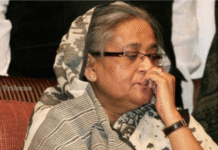Dhaka is suffering from growing pains but it can use an IMF bailout to further clean up its economy.
Photographer: MUNIR UZ ZAMAN/AFP
In the middle of the Covid-19 pandemic, and exactly 50 years after it became independent, Bangladesh passed a major test. Last year, the United Nations decided to strike the South Asian economy off its list of the world’s least developed nations. In fact, its per capita national income is now higher than that of India next door. Celebrations, however, were interrupted by a rude jolt: A hard-currency shortage serious enough to require a bailout by the International Monetary Fund.
Will the imbalance derail the graduation ceremony, which the UN has set for 2026? More importantly, will it slow down progress toward the next milestone: an upper-middle-income status for its 167 million people in the next 20 years? Bangladesh’s bigger neighbor can offer some clues — and lessons.
A cheaper taka will quicken inflation from a nine-year high of 7.6% by raising the cost of imported energy. Shortages of expensive natural gas are threatening power cuts through 2026, hurting manufacturers. There could be ripple effects. If the dollar crunch precipitates a deep slowdown and a surge in bad loans, rescuing the financial sector with taxpayers’ money may put the government’s junk-grade credit rating (Ba3, according to Moody’s Investors Service) under strain.
This is where policy makers could draw a parallel with India, the largest economy in South Asia. The first clue is that a hard-currency financing crunch — the kind that besets almost every developing country occasionally — does slow things down if it impairs the domestic banking system. When the Indian central bank ran out of dollars for imports in 1990-91 and New Delhi had to seek an IMF rescue, India’s per capita income was $390. For a $10 increase to $400, the country had to wait until 1996. It took that long partly because — even three years into stabilization — a quarter of the Indian banking system’s assets were nonperforming.
Bangladesh’s Success: Can It Last?
The garment-exporting economy has overtaken India in per capita gross national income. Dwindling foreign exchange reserves can stop it in the tracks
Source: World Bank
A second lesson is that the lean years must be spent on reforms that would give the economy a fresh growth spurt: In India’s case, it meant lowering trade barriers, dismantling industrial licensing, and joining up local enterprises with global capital. That gave India enough fuel to nearly quadruple the 1996 per capita income to $1,500 by 2012. But because India hadn’t done enough to improve the governance of its financial system, excessive credit directed toward large projects of dubious value eventually became a dampener.
What went right for Bangladesh? For one thing, it played to its strength, garnering a slice of global low-skill exports — readymade garments — in line with its share of working-age people among poor countries. India went for high-skilled software, business-process outsourcing and finance, benefiting a tiny fraction of its 1 billion-person-strong workforce, according to a 2020 paper by economist Shoumitro Chatterjee of Pennsylvania State University and Arvind Subramanian, formerly India’s chief economic adviser. New research by Amit Basole, an economist at the Azim Premji University in Bengaluru, shows the difference in outcomes: Bangladesh generated three times more employment from every 1% of output growth than India between 2010 and 2018.
Bangladesh’s Credit Challenge
About 40% of the banking system’s assets are earning annual returns of less than 0.5%. To raise growth capital, lenders must boost profitability
Source: Bloomberg
Bangladesh has an opportunity to use the IMF program to “initiate a round of house-cleaning,” Ahsan H. Mansur, executive director of Dhaka-based Policy Research Institute, told Bloomberg News. It should grab the chance. But as it does that, perhaps the biggest lesson policy makers can draw from their neighbor is to not throw away seeds of broad-based wage growth and prosperity.
Leaving the club of the world’s poorest nations on the back of a 1,000-fold jump in its textile exports since the mid-1980s is a stellar feat. Now comes the hard part. To get to an upper-middle-income status, the average Bangladeshi has to earn 60% more. That will require credit for industry and infrastructure. But the financial system is underdeveloped: Publicly traded banks’ 14 trillion taka ($150 billion) in assets are equivalent to only about 40% of gross domestic product. Worse, about 40% of banking assets are earning returns of less than 0.5%, suggesting misallocation of capital. India left this problem unattended for far too long. Bangladesh shouldn’t repeat the mistake.
More From This and Other Writers at Bloomberg Opinion:
- South Asia Should Pay Heed to Its Standout Star: Mihir Sharma
- The Next China? India Must First Beat Bangladesh: Andy Mukherjee
- Big Apparel Brands Still Need Bangladesh’s Workers: Adam Minter
Want more from Bloomberg Opinion? Terminal readers head to OPIN <GO>. Web readers, click here.
This column does not necessarily reflect the opinion of the editorial board or Bloomberg LP and its owners.
To contact the editor responsible for this story:
Howard Chua-Eoan at hchuaeoan@bloomberg.net










